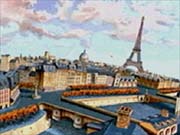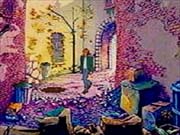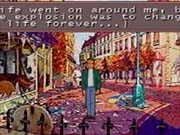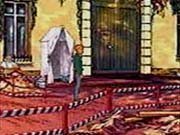Broken Sword Q&A
Find out how Revolution Software and Bam Entertainment are bringing Broken Sword to the GBA in our Q&A.
The Broken Sword games on the PC and the PlayStation have been well received by gamers thanks to strong storylines, detailed graphics, and atmospheric music. While bringing the series from the PC to the PlayStation was a fairly natural progression, developing a Broken Sword game on the Game Boy Advance doesn't sound like a viable option. However, developer Revolution Software thinks otherwise and is set to bring the series to the GBA. We talked to Charles Cecil, managing director at Revolution Software, to find out how you take a graphics-intensive PC and PlayStation series and make it fit on the Game Boy Advance.
GameSpot: How do you go about converting a game like Broken Sword to the GBA?
Charles Cecil: With great care! The idea for Broken Sword on the Game Boy Advance actually started as a flippant suggestion. We investigated and discovered that we could just about write the game but were determined to only do so if we could get a great resulting game.
The game isn't really a conversion; it is more of a reinterpretation. We decided to reimplement the game from scratch rather than simply convert it. This has allowed us to create a completely different direct-control interface, which works really well and is almost truer as an interface than the original point-and-click. It has also allowed us to tweak some of the puzzles, such as the ubiquitous goat-and-plow obstacle that tripped so many people up previously. We have also reduced the amount of dialogue. And we were also able to add unique elements specific to the Game Boy Advance version.

GS: How large is the team working on the game? How long has the game been in development?
CC: We've had a team of six people working on the game, plus external production under the vigilant watch of the development team at Bam. The programmers have written GBA-specific engine and tools, artists have taken the original art assets and adapted them, and three designers have completely reimplemented the game. It will have taken us nearly a year to complete the project. Much of this time was spent experimenting with the technology and the control interface, both of which were vital elements.
GS: What did you feel were the most important gameplay and graphic elements to retain on the GBA?
CC: When we launched the original game on the PC and, later, the PlayStation, there were no expectations. What we did was revolutionary in terms of adventures. This time around, and despite the fact that we believe the GBA version will appeal to a host of gamers who've never experienced the series before, we are aware that there are high expectations. We decided that the game must retain the quality of the visuals as much as possible and that a unique interface must be written to suit the GBA.

We felt that the visual look needed to be maintained, despite the limited memory. We employed some extraordinary compression that has allowed us to faithfully include most of the assets, except for speech, which would have been impossible. All the characters, locations, objects, and puzzles are fully featured. We have been able to include a full complement of sound effects and musical themes.
GS: Did you make any changes to the gameplay to take into account the platform it's going to be on?
CC: The game was implemented specifically for the GBA so there have been many gameplay elements that have been designed specifically to suit the format. We want the game to be really easy to play. With regard to the interface, we have opted for a direct control with a cursor appearing as the player passes hot spots. To avoid the frustration of not knowing what one can do, we have incorporated a "vista" menu, which allows the player to highlight hot-spot objects in the screen. It enables players to concentrate on the solution to the problems rather than wrestling with controls. Also, we've simplified the inventory to ensure that it's quick and easy to use the objects within the adventure. We are really pleased with the results.

GS: How much of a challenge was it working with the hardware?
CC: Despite the excellent hardware, it has been a colossal job to get the game into a cartridge. The original PC version had 1.2Gb of data; here we have 8Mb Obviously the GBA version doesn't feature speech, and with the graphics being smaller they of course occupy less memory. But even so, that has been a challenge, yet one we've really enjoyed!
GS: How have you managed working with the GBA's sound chip?
CC: We've worked closely with Barrington Pheloung, the composer of the original score, to ensure that all the significant cues have been included in the GBA version. We're using a complex music playback system that allows us to incorporate considerably more music than would have previously been possible had we used the PC method of waveform playback. Barry has been great, supplying us with MIDI files for all the cues in the game and also the orchestral samples from his own studio--samples that were used to create the music in the original Broken Sword. We're investing a lot of time and effort in the music for this title, because we know how important it was in maintaining the atmosphere of the original!

GS: How long is the game?
CC: This is such a difficult question to answer. We anticipate gamers who have never played Broken Sword before taking around 30 hours to finish it. Even those that have finished the game before, though, will find new elements, which have echoes in both Broken Sword 2 and the forthcoming Broken Sword: The Sleeping Dragon.
GS: How did you go about developing the story?
CC: The original story was a result of my own personal fascination with the Knights Templar. It is an amazing tale involving conspiracy, huge wealth, power, and corruption. We decided to integrate the mystery of the Knights Templar within a modern-day setting, and it's amazing how plausible the whole plot really is. In fact, I think that much of it may really be true. We're extremely proud of the fact that many people who have played the original Broken Sword go on to develop an interest in this fascinating medieval order.
GS: How did you balance keeping the game accessible to fans of the series while not leaving out gamers new to Broken Sword games?
CC: There are a number of new elements that are unique to the game. However, we hope that those who have played the first game will see this new version like rereading a favorite book. No one will remember the solution all the way through, so whatever the familiarity of the player, they will still be challenged.
GS: What are you proudest of accomplishing in the game?
CC: I am very proud of the game and particularly that it is so much more than simply a conversion. It would be difficult to pick one element out, but, if pushed, I would say the interface because it feels better than any of the other versions.
Thanks to Charles Cecil for his time. Broken Sword ships later this year for the Game Boy Advance.
Got a news tip or want to contact us directly? Email news@gamespot.com
Join the conversation